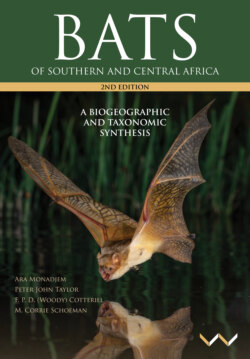Читать книгу Bats of Southern and Central Africa - Ara Monadjem - Страница 36
На сайте Литреса книга снята с продажи.
Escarpments
ОглавлениеThe margins of the Kalahari Plateau are edged with steep escarpments, comprising a single horseshoe arc. In the south, the high relief of the Cape Fold Belt forms a partial arc against these greater escarpments flanking southern Africa that extend west and east. The eastern escarpment is dominated by the rim of the Drakensberg Massif, continuing north in the Lebombo and Mpumalanga mountains, and farther northeast into East Africa. In Zimbabwe, the Eastern Highlands dominate the topography, especially in contrast to the Mozambique coastal plain. The Livingstone Mountains, bounding the eastern edge of the Nyasa (Malawi) graben (Smithers and Lobão Tello 1976), form the northern margin of the plateau (albeit recently modified by the Malawi rift). On the Atlantic coast, the western margin of the Kalahari Plateau is formed by the mountainous flanks of the Bokkeveld and Namaqua plateaux, and extends northwest through Namibia. It reappears north of the Kunene River’s incision in the high mountain land of western Angola.
The topography of southern Africa has been influenced by past tectonic events, which have expressed both subtle and dramatic effects across the subcontinent. The most dramatic evidence lies in the East African Rift System, exemplified in the deep graben occupied by lakes Tanganyika and Malawi. A southwestern extension of the East African Rift accounts for the remarkably varied topography of Katanga in the DRC, especially the Kundulungu and Kibara plateaux, which at over 1,800 m above sea level dominate the adjacent Kamalondo and Lufira depressions (whose lowest elevations lie below 600 m above sea level) (Broadley and Cotterill 2004, Cotterill 2005). There are steep escarpments in this region, most notably Zambia’s Muchinga Escarpment, which bounds the western edge of the Luangwa valley. The significance of the Muchinga Escarpment as a biogeographical boundary was originally emphasised by Neave (1907, 1910a, b) and Ansell (1978). The enhancement of the Muchinga Escarpment by the East African Rift created a prominent eastern bound to the Kalahari Plateau; this rugged scarp extends south, bordering the Gwembe trough, markedly eroded by the Middle Zambezi (today artificially impounded in Lake Kariba at Kariba Gorge).
Equally impressive escarpments form the steep flanks of the Middle Zambezi valley in Zambia and Zimbabwe (Cotterill 2003, Moore et al. 2009, 2020) (Figure 28). These escarpments bound formerly extensive landscapes, and have witnessed a prolonged history of uplift and erosion that has persistently lifted and warped the Kalahari Plateau, faulting its margins in parts (de Wit 2007).
